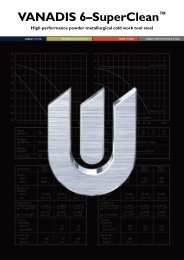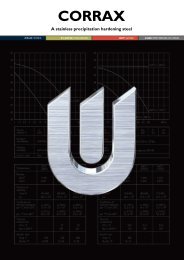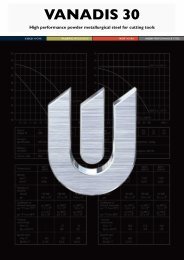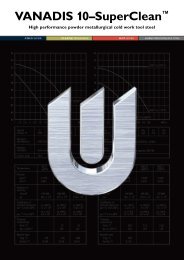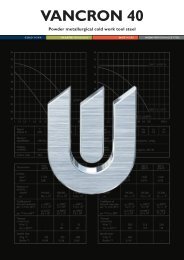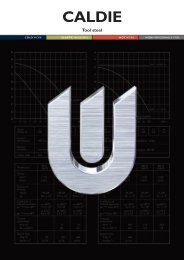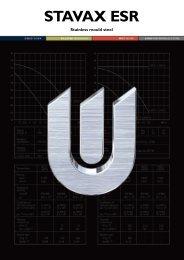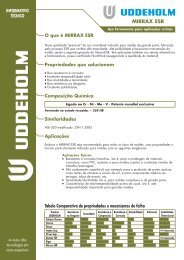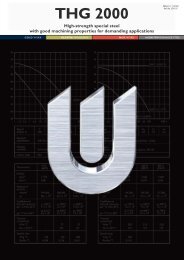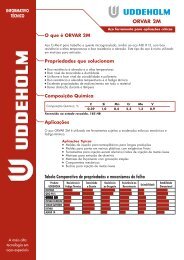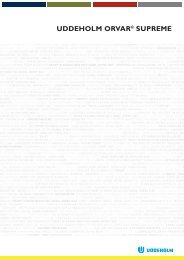IMPAX SUPREME - Uddeholm
IMPAX SUPREME - Uddeholm
IMPAX SUPREME - Uddeholm
- No tags were found...
You also want an ePaper? Increase the reach of your titles
YUMPU automatically turns print PDFs into web optimized ePapers that Google loves.
<strong>IMPAX</strong> <strong>SUPREME</strong><strong>IMPAX</strong> <strong>SUPREME</strong>Prehardened mould steel1
<strong>IMPAX</strong> <strong>SUPREME</strong>General<strong>IMPAX</strong> <strong>SUPREME</strong> is a premium-quality vacuumdegassedCr-Ni-Mo-alloyed steel which is suppliedin the hardened and tempered condition, offeringthe following benefits:■ No hardening risks■ No hardening costs■ Time saving, e.g. no waiting for heat treatment■ Lower tool cost (e.g. no distortion to rectify)■ Modifications easily carried out■ Can be subsequently nitrided to increase surfacewear resistance or locally flame hardened toreduce surface damage.<strong>IMPAX</strong> <strong>SUPREME</strong> is manufactured to consistentlyhigh quality standards with a very low sulphurcontent, giving a steel with the following characteristics:■ Good polishing and photo-etching properties■ Good machinability■ High purity and good homogeneity■ Uniform hardness.Note: <strong>IMPAX</strong> <strong>SUPREME</strong> is 100% ultrasonic tested.Heavier sections are supplied premachined whichoffers the following advantages compared with unmachinedmaterial:• Saving of weight• Non-decarburized surface• Exact nominal size (plus tolerance)• Less machining• Absence of scale minimizes machine andtool wear.Applications• Injection moulds for thermoplastics• Extrusion dies for thermoplastics• Blow moulds• Forming tools, press-brake dies (possibly flamehardened or nitrided)• Aluminium die casting prototype dies• Zinc die casting dies• Long run die shoes• Structural components, shafts.PropertiesPHYSICAL DATAHardened and tempered to 310 HB.Temperature 20°C 200°C(68°F) (390°F)Density,kg/m 3 7 800 7 750lbs/in 3 0,282 0,280Coefficient of thermalexpansionper °C from 20° – 12,7 x 10 -6per °F from 68°F – 7,0 x 10 -6Thermal conductivityW/m °C 29,0 30Btu in/ft 2 h °F 202 205Modulus of elasticityN/mm 2 205 000 200 000tsi 13 280 12 960psi 29,7 x 10 6 29,0 x 10 6Specific heat capacityJ/kg °C 460 –Btu/lb°F 0,110 –Approx.analysis %Standardspec.DeliveryconditionColourcodeC Si Mn Cr Ni Mo S0,37 0,3 1,4 2,0 1,0 0,2
<strong>IMPAX</strong> <strong>SUPREME</strong>The graph below shows how the impact energychanges as a function of the test temperature andhardness variation within the delivery hardnessrange.Impact energy, J (Charpy V)1009080706050403020100–100 –50 0 50 100 150°C–148 –58 32 122 212 302°FTemperatureTensile strengthApprox. values. Samples were taken from a flat bar,90 x 300 mm (3,5" x 11,8"). Hardness: 325 HB.Testing temperature 20°C 200°C(68°F) (390°F)Ultimate tensile strengthR m N/mm 2 1020 930Yield strengthR p0,2 N/mm 2 900 800Compressive strengthCompressiveyield strength Rc0,2 N/mm 2 850–1000Heat treatment<strong>IMPAX</strong> <strong>SUPREME</strong> is intended for use in the hardenedand tempered condition, i.e. the deliverycondition.When, however, the steel is to be heat treated to ahigher hardness or case hardened, the followinginstructions may be helpful.SOFT ANNEALINGProtect the steel and heat through to 700°C(1300°F). Then cool in the furnace at 10°C (50°F)per hour to 600°C (1110°F), then freely in air.STRESS-RELIEVINGAfter rough machining the tool should be heatedthrough to 550°C (1020°F), holding time 2 hours.Cool slowly to room temperature.HARDENINGNote: The steel should be fully soft annealed beforehardening.Preheating temperature: 500–600°C (930–1110°F).Austenitizing temperature: 850°C (1560°F).The steel should be heated through to the austenitizingtemperature and held at temperature for30 minutes.Protect the tool against decarburization andoxidation during the hardening process.QUENCHING MEDIA■ High speed gas/circulating atmosphere. (Onlysuitable for small dimensions)■ Oil■ Martempering bath 300°C (570°F) max.4 minutes, then air.Note: Temper immediately tool reaches 50–70°C(120–160°F).Large mould to produce laundry-baskets.Suitable grade for this moulding tool is <strong>IMPAX</strong> <strong>SUPREME</strong>.3
<strong>IMPAX</strong> <strong>SUPREME</strong>TEMPERING GRAPHChoose the tempering temperature according to thehardness required by reference to the temper-inggraph. Temper twice with intermediate cooling toroom temperature. Lowest tempering temperature180°C (360°F) for small inserts, but preferredminimum is 250°C (480°F). Holding time at temperatureminimum 2 hours.The diagram is valid for small samples 15 x 15 x40 mm (0,6 x 0,6 x 1,6 in.) austenitized 30 min. at850°C (1560°F), quenched in air and tempered2 + 2 hours.HardnessHRC HB55 60055050 50045045400403503530 300250200100 200 300 400 500 600 700°C210 390 570 750 930 1110 1290°FTempering temperatureMachiningrecommendationsThe cutting data below are to be considered asguiding values which must be adapted to existinglocal conditions. More information can be found inour “Cutting data recommendations”.TURNINGTurningTurning with carbide with highspeed steelCutting data Rough Fine Fineparameters turning turning turningCutting speed(v c )m/min. 110–150 150–180 15f.p.m. 365–500 500–600 50Feed (f)mm/r 0,3–0,6 –0,3 –0,3i.p.r. 0,01–0,024 –0,01 –0,01Depth of cut(a p )mm 2–6 –2 –2inch 0,08–0,24 –0,08 –0,08Carbide designationISO P20–P30 P10 –Coated Coatedcarbide carbide orCermetFLAME AND INDUCTION HARDENING<strong>IMPAX</strong> <strong>SUPREME</strong> can be flame or inductionhardened to a hardness of approx. 50 HRC. Coolingin air is preferable.Further information can be obtained from the<strong>Uddeholm</strong> Technical Services Report “Flamehardeningof <strong>IMPAX</strong> <strong>SUPREME</strong>”.CASE HARDENINGIn order to increase the surface hardness, <strong>IMPAX</strong><strong>SUPREME</strong> can be case hardened. Further informationcan be obtained from your local <strong>Uddeholm</strong>office.NITRIDING AND NITROCARBURIZINGNitriding gives a hard surface which is very resistantto wear and erosion. A nitrided surface alsoincreases the corrosion resistance.For best result the following steps should befollowed:1. Rough machining2. Stress tempering at 550°C (1020°F)3. Grinding4. Nitriding.DRILLINGHigh speed steel twist drillDrill diameter Cutting speed (v c) Feed (f)mm inch m/min f.p.m. mm/r i.p.r.–5 –3/16 15* 50 0,08–0,15 0,003–0,0065–10 3/16–3/8 15* 50 0,15–0,25 0,006–0,01010–15 3/8–5/8 15* 50 0,25–0,30 0,010–0,01215–20 5/8–3/4 15* 50 0,30–0,35 0,012–0,014* ) For coated HSS drill v c≈ 20 m/min. (65 f.p.m.)Carbide drillType of drillCutting data Indexable Solid Brazedparameters insert carbide carbide 1)Cutting speed(v c )m/min. 130–180 55 45f.p.m. 435–600 185 150Feed (f)mm/r 0,05–0,25 2) 0,10–0,25 2) 0,15–0,25 2)i.p.r. 0,002–0,01 2) 0,004–0,01 2) 0,006–0,01 2)1)Drill with internal cooling channels and brazed carbide tip.2)Depending on drill diameter.4
<strong>IMPAX</strong> <strong>SUPREME</strong>MILLINGFace and square shoulder face millingMillingwith highMilling with carbide speed steelCutting data Rough Fine Fineparameters milling milling millingCutting speed(v c )m/min. 80–110 110–130 16f.p.m. 265–365 365–435 55Feed (f z )mm/tooth 0,2–0,4 0,1–0,2 0,1inch/tooth 0,008–0,016 0,004–0,008 0,004Depth of cut(a p )mm 2–5 –2 –2inch 0,08–0,20 –0,08 –0,08Carbide designationISO P20–P40 P10–P20 –Coated Coatedcarbide carbide orCermetWeldingGood results when welding tool steel can beachieved if proper precautions are taken duringwelding (elevated working temperature, joint preparation,choice of consumables and welding procedure).If the tool is to be polished or photoetched,it is necessary to work with an electrodetype of matching composition.Welding method TIG MMA (SMAW)Working 200–250°C 200–250°Ctemperature (390–480°F) (390–480°F)<strong>IMPAX</strong>Consumables TIG-WELD <strong>IMPAX</strong> WELDHardnessafter welding 320–350 HB 320–350 HBFurther information is given in the <strong>Uddeholm</strong>brochure “Welding of Tool Steel”.End millingMilling cutterCarbideCutting data Solid indexable High speedparameters carbide insert steelCutting speed(v c )m/min. 50 100–150 17 1)f.p.m. 165 335–500 57 1)Feed (f z )mm/tooth 0,03–0,20 2) 0,08–0,20 2) 0,05–0,35 2)inch/tooth 0,001–0,008 2) 0,003–0,008 2) 0,002–0,014 2)Carbide designationISO K10, P40 P20–P40 –1)For coated HSS end mill v c ≈ 24 m/min. (78 f.p.m.)2)Depending on radial depth of cut and cutter diameter.GRINDINGA general grinding wheel recommendation is givenbelow. More information can be found in the<strong>Uddeholm</strong> brochure “Grinding of Tool Steel”.Electrical-dischargemachiningIf spark-erosion, EDM, is performed in the asde-livered condition, the tool should then be givenan additional temper at approx. 550°C (1020°F).If the steel has been rehardened, the additionaltempering temperature should be 25°C (50°F) lowerthan the last tempering temperature used.Further information can be obtained from the<strong>Uddeholm</strong> brochure “EDM of tool steel”.Hard-chromium-platingAfter hard-chromium-plating, the tool should betempered for approx. 4 hours at 180°C (350°F)within 4 hours of plating in order to avoid hydrogenembrittlement.Type of grindingFace grinding straight wheelFace grinding segmentsCylindrical grindingInternal grindingProfile grindingWheel recommendationA 46 HVA 24 GVA 46 LVA 46 JVA 100 LVPhoto-etching<strong>IMPAX</strong> <strong>SUPREME</strong> is particularly suitable for texturingby the photo-etching process. Its very lowsulphur content ensures accurate and consistentpattern reproduction.For heavy sections an extra tempering at 550°C(1020°F) before photo-etching is recommended.5
<strong>IMPAX</strong> <strong>SUPREME</strong>Polishing<strong>IMPAX</strong> <strong>SUPREME</strong> has good polishability in thehardened and tempered condition.After grinding, polishing is undertaken withaluminium oxide or diamond paste.Note: Each steel grade has an optimum polishingtime which largely depends on hardness andpolishing technique. Overpolishing can lead to apoor surface finish (e.g. an “orange peel” effect).Further information is given in the <strong>Uddeholm</strong>publication “Polishing of mould steel”.Further informationContact your local <strong>Uddeholm</strong> office for furtherinformation on the selection, heat treatment, applicationand availability of <strong>Uddeholm</strong> tool steels,including the publication “Steels for moulds”.6



